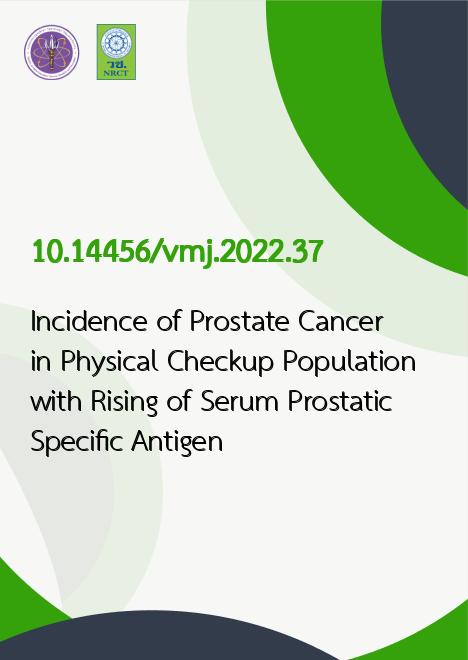
|
Incidence of Prostate Cancer in Physical Checkup Population with Rising of Serum Prostatic Specific Antigen |
|---|---|
| รหัสดีโอไอ | |
| Creator | 1. Krittin Naravejsakul 2. Tharadon Pothisa PharmD 3. Nunthakarn Saenrak |
| Title | Incidence of Prostate Cancer in Physical Checkup Population with Rising of Serum Prostatic Specific Antigen |
| Publisher | Text and Journal Publication |
| Publication Year | 2565 |
| Journal Title | Vajira Medical Journal |
| Journal Vol. | 66 |
| Journal No. | 5 |
| Page no. | 355-360 |
| Keyword | International prostate symptom score, Prostate specific antigen, lower urinary tract symptoms |
| URL Website | https://tci-thaijo.org/index.php/VMED |
| Website title | Vajira Medical Journal (วชิรเวชสาร) |
| ISSN | 0125-1252 |
| Abstract | Objective: To assess the prevalence of prostate cancer in northern Thailand. Methods: This study was performed with a cohort study at the health check-ups clinic at University of Phayao Hospital from July 2021 until October 2021. In total, prostate gland check-ups and Prostate-specific antigen (PSA) screening was made available to 350 patients aged at least 45 years, and a number of parameters were recorded: International prostate symptom score (IPSS), Body mass index (BMI), Digital Rectal Examination (DRE) and Quality of Life score (QOL) score. Those patients whose PSA level was more than 4 ng/ml were advised to have a transrectal ultrasound (TRUS) biopsy of prostate. The cancer detection rate was determined on the basis of reported symptoms and the IPSS. Comparisons among data were assessed via the Chi-square test, while Spearman correlation was used to compare the PSA level and the Gleason score. Results: For the study subjects, the median age was 63 years (45-81); median BMI was 23.4 (18.2-32.4) kg/m2, median IPSS score was 11(0-32); median QOL score was 2(0-6); and median PSA was 1.23 (0.12-125.7) ng/ml. Upon biopsy, 7.54% of the sample participants (26/350) could be determined to have prostate adenocarcinoma. A majority of those cases exhibited localized lesions. Participants who considered themselves to have abnormal urination were more likely to also have prostate cancer. Only one prostate cancer case was discovered in a participant with mild LUTS, as indicated by IPSS below 8. Typically, prostate cancer occurred more frequently in males with high IPSS scores. Conclusion: The PSA screening approach detected prostate cancer in 7.54% of healthy physical check-ups population. A majority of these cancer cases were already presenting symptoms. Patients with LUTS should be made aware of prostate cancer and PSA testing may be offered in such patients. |